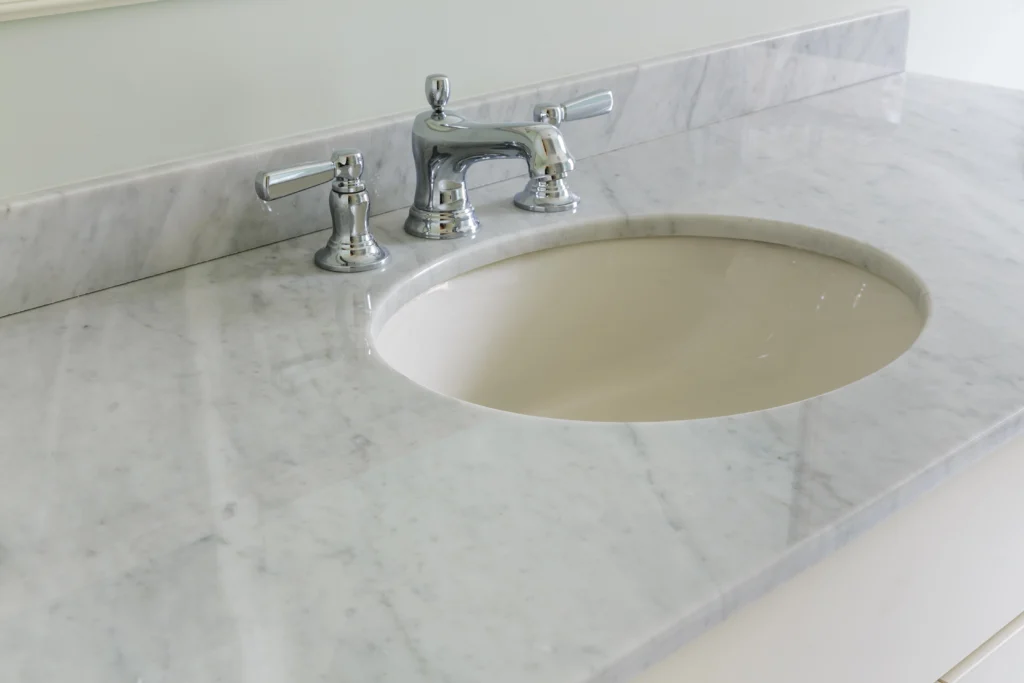What is cultured marble made of? Cultured marble is a man-made material composed of a blend of various elements. This engineered stone combines resins, fillers, pigments, and additives to replicate the look and feel of natural marble. Unlike natural marble, which is quarried from stone, cultured marble is created through a meticulous manufacturing process that involves mixing these components to achieve desired colors, patterns, and textures.
What is Cultured Marble of ?

Cultured marble is a blend of crushed marble stone and a polymer resin that is used to create various products like countertops, bathtubs, sinks, and shower walls. Here’s a breakdown:
Definition and Characteristics:
Cultured marble is a man-made material designed to mimic the look of natural marble. It’s known for its durability, versatility, and affordability compared to natural marble. This material can be shaped into different forms and comes in various colors and patterns, offering a consistent appearance throughout the product.
What is cultured marble made of:
It’s primarily composed of crushed marble stone, which provides its natural elegance and appearance, combined with a polymer resin (usually polyester resin). This resin binds the crushed marble together, forming a solid surface that can be molded into different shapes.
Comparisons with Natural Marble:
Appearance: Cultured marble can closely resemble the appearance of natural marble, but since it’s manufactured, the patterns and colors can be more consistent. However, natural marble tends to have more unique veining and patterns.
Durability: Cultured marble is generally more resistant to scratches and stains compared to natural marble. It’s also less prone to chipping and damage.
Maintenance: Natural marble requires more maintenance, as it is porous and can absorb liquids, making it prone to staining. Cultured marble, being non-porous, is easier to clean and maintain.
Cost: Cultured marble is typically more affordable than natural marble. The manufacturing process allows for cost-effective production, making it a popular choice for budget-friendly options that still offer an elegant appearance. If you want professional guidance then Stone sealer restoration is the best choice for you.
Composition of Cultured Marble

Primary Ingredients:
Resins: These are synthetic materials that serve as the binding agent in cultured marble. Resins play a crucial role in holding the entire mixture together, providing cohesion and strength.
Fillers: These are materials like crushed limestone, marble dust, or other minerals. Fillers add bulk, density, and structure to the cultured marble while contributing to its overall appearance and characteristics.
Secondary Components:
Pigments: Pigments are colorants added to cultured marble to achieve various colors and patterns. They offer a wide range of customization options, allowing for different aesthetics in the final product.
Additives: Additives are additional substances incorporated into the mixture to modify specific properties of the cultured marble. These additives may include materials to enhance durability, improve texture, or provide other desired features.
Pros and Cons of Cultured Marble
Advantages of Using Cultured Marble:
Durability: It’s relatively durable and can withstand daily use without easily cracking or breaking, making it a suitable choice for surfaces like countertops or vanities.
Versatility in Design: Cultured marble can be molded into various shapes and sizes, allowing for custom designs and flexibility in creating different styles for bathrooms and kitchens.
Cost-Effectiveness: Compared to natural marble, cultured marble tends to be more affordable. It provides a similar aesthetic appeal without the high price tag, making it an attractive option for those on a budget.
Drawbacks or Limitations:
Vulnerability to Scratches: Despite its durability, cultured marble is prone to scratching, especially when exposed to sharp objects or abrasive cleaning materials. Over time, these scratches can diminish its appearance.
Environmental Impact: The production of cultured marble involves the use of resins and other chemicals that may have an environmental impact. Additionally, disposing of cultured marble can be challenging due to its non-biodegradable nature.
Maintenance Requirements: Regular maintenance is necessary to preserve its appearance. It may require periodic sealing to prevent stains and damage, and specific cleaning agents to avoid discoloration or deterioration. Marble services can cost much and if you avoid maintenance it may become less appealing.
Conclusion
Cultured marble is a composite material composed of crushed marble stone and a polymer resin, creating a durable and versatile material used in various applications like countertops, sinks, and bathtubs. The combination of marble particles and resin gives it a polished finish similar to natural marble but with enhanced strength and easier maintenance. Feel free to contact us for any type of query or the services related to queries like what is cultured marble made of.
FAQs
What Materials Make Up Cultured Marble?
Cultured marble is primarily made of crushed marble stone and a polyester resin.
Is Cultured Marble Completely Synthetic?
No, it contains natural marble stone particles mixed with the resin, giving it a natural look and feel.
Are There Variations In The Composition Of Cultured Marble?
Yes, while marble and resin are the primary components, additives like pigments or fillers may vary based on the manufacturer.
Is Cultured Marble More Durable Than Natural Marble?
Generally, yes. Its composite nature enhances durability, making it less prone to cracks and stains compared to natural marble.
Can Cultured Marble Be Customized?
Absolutely! It can be molded into various shapes and sizes during the manufacturing process, allowing for customization.
How Does The Composition Affect Its Appearance?
The combination of marble and resin gives cultured marble a polished finish similar to natural marble but with more flexibility in color and design.
